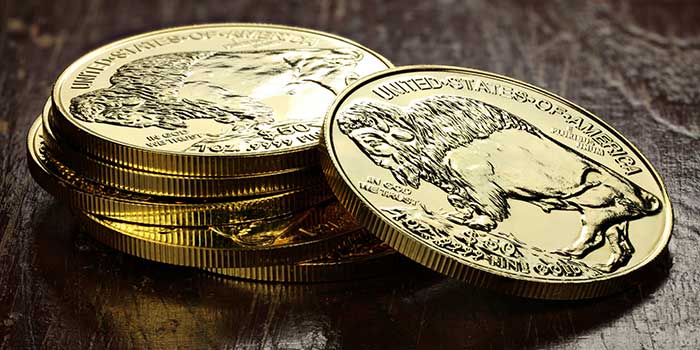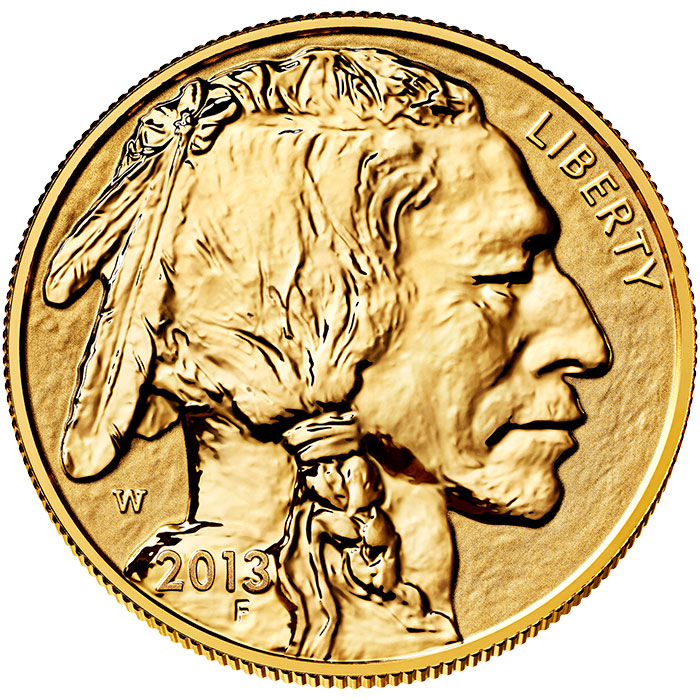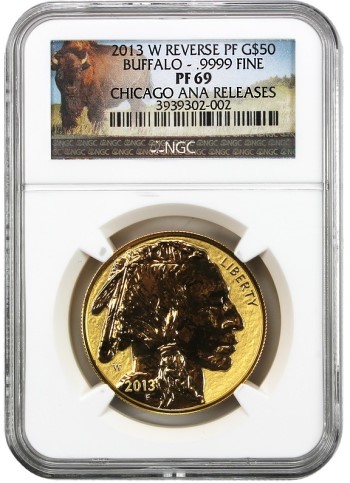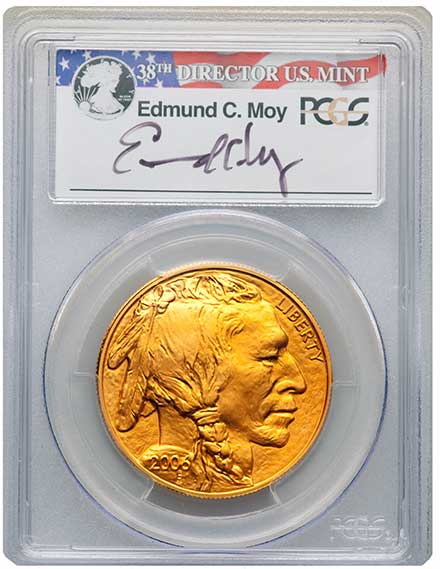
By Tyler Rossi for CoinWeek …..
The American Gold Buffalo program started in an interesting manner when the United States Congress introduced the new gold bullion coin as part of the Presidential $1 Coin Act of 2005. Not only did the bill lay out the design to be used (a modified version of James Earle Fraser’s Native American Buffalo/Indian Head design, which debuted in 1913 on the nickel) but it also included a number of other stipulations. Perhaps most notably, it stipulated that all the gold used in these coins was to be “mined from natural deposits in the United States, or in a territory or possession of the United States” and that it be used within one year of the date it was mined. Additionally, as numismatic collectors’ products, the coins were to be sold for “not less than the sum of the market value of the bullion at the time of sale; and the cost of designing and issuing the coins, including labor, materials, dies, use of machinery, overhead expenses, marketing, and shipping.”
Basically, the coins were to be as American as possible and not lose the Federal Government money when first released to the public on June 20, 2006.
Unlike many other U.S. bullion coins, which are available for purchase directly from the United States Mint, Uncirculated Gold Buffalos were to be sold exclusively through authorized dealers who purchased the pieces directly from the Mint for later resale – both to other dealers and private collectors. Proof types, however, are sold directly to the public by the Mint.
 While all Gold Buffalos are struck by the U.S. Mint facility at West Point, the vast majority do not have a mint mark. Those that do include all Proof releases and the 2013 Reverse Proof and 2008 Burnished Uncirculated special issues. On all of these pieces, a small “W” can be found on the obverse to the left of the Indian chief’s neck.
While all Gold Buffalos are struck by the U.S. Mint facility at West Point, the vast majority do not have a mint mark. Those that do include all Proof releases and the 2013 Reverse Proof and 2008 Burnished Uncirculated special issues. On all of these pieces, a small “W” can be found on the obverse to the left of the Indian chief’s neck.
Unlike the Chinese Gold Panda, which changes its design annually, and the Canadian Gold Maple Leaf, which presents numerous commemorative types, the Gold Buffalo design remains consistent year in and year out. The only adjustments come in the form of the finish applied. This puts the Buffalo in the same camp as the South African Krugerrand. To date, the Gold Buffalo has come in standard circulation finish (2006-2023), Proof (2006-2023), Reverse Proof (2013), and a Burnished Uncirculated finish (2008). This means that when looking at online third-party sales, prices across dates within the same finish remain very stable.
So which Gold Buffalo should collectors look to buy?
The answer is simple: it depends.
It depends on what your aim as a collector is. Are you a gold stacker who wants to get the most bullion for the lowest price? If so, I would advise going to your local coin dealer or coin show and purchasing a random date bullion finish coin. At the current spot price of gold ($1,836.60 per ounce at the time of writing), you can spend between $1,900 and $2,000 USD on a random date example. This represents a 5% to 9% premium over melt.
However, if you’re looking to put together a type collection, perhaps an MS 70 of each finish will do the trick. In this case, you only need to buy four coins: the 2013 Reverse Proof, the 2008 Burnished Uncirculated finish, a standard finish, and a Proof example. A 2013 MS 70 Reverse Proof will run you between $2,500 and $2,600–a roughly 35% to 40% premium over melt. Struck to celebrate the 100th Anniversary of the first Buffalo nickel, this is a special part of the series. That being said, this price has remained relatively stable over the past year, staying at between $2,500 and $3,100.
 Unlike Buffaloes with the standard strike, this means the Reverse Proof type is semi-numismatic and not simply a bullion coin.
Unlike Buffaloes with the standard strike, this means the Reverse Proof type is semi-numismatic and not simply a bullion coin.
Next, due to their pure bullion value even in MS 70, a random-year standard finish will cost only slightly more than an MS 65 through 69, perhaps a difference of $100 or less.
Struck from specially prepared burnished planchets with a satin-like finish, 2008 Burnished Uncirculated Gold Buffaloes were sold by the Mint not only individually as the standard 1 oz denomination (starting on July 22, 2009, at $1,059.95) but also as part of a four-part set with the $5, $10, and $25 fractional denominations for $1,959.95. Today, the individual coin sells for around $3,800.
To complete this type set, our hypothetical collector would need to acquire a Proof finish piece. Struck annually over the entire series (since 2006), the Proof version has been marketed to collectors as a numismatic offering above the standard bullion issuance. Using highly polished blank planchets and specially prepared dies with sand-blasted surfaces, these Proof coins boast highly mirrored fields and sharp frosted details. As semi-numismatic pieces, Proof Buffaloes sell for a premium similar to the 2013 Reverse Proof type. For example, Proof 70 coins of all dates sell for between $2,450 and $3,150 on average – roughly a 25% to 50% premium over the standard issue.
In total, this four-piece type set of Mint State and Proof 70s set will cost approximately $10,000 to $12,000.
Lastly, let’s explore the other options available to our hypothetical collector who simply wishes to acquire a couple of examples that they believe may increase in value. While all of these prices are extremely dependent on the spot price of gold, there are a few other pieces to look for.
As with other gold bullion coins issued by governments around the world, an important part of any series is the first year of issuance. As such, I would suggest that collectors look at purchasing an 2006 standard finish Buffalo in MS 70. The grade is important because, as a bullion coin, anything less than perfect will trade for the standard 5% to 10% premium over melt. It is only with perfect MS 70s that collectors are sometimes willing to pay larger premiums.
Additionally, I would say collectors should look to acquire a coin in a special holder. While I do not personally go for coins with these types of special labels, they can, in this case, lend serious value to the coin.

For example, in June 2021, a PCGS First Strike 2006 with a label signed by former Mint Director Edmund C. Moy sold for $2,880 in Heritage Auctions’ 2021 June 29 Modern Collectible and Bullion U.S. Coins Showcase Auction. There happen to be a few interesting parts to this sale. First off, the average bullion spot price for that month was $1,834, meaning that this lot sold for a massive 57% premium. The price can be attributed mostly to the PCGS hand signed label, as other comparable coins in standard holders sold for $500 to $700 less around the same time. Additionally, at the time of the sale, there were only 10 MS 70-certified 2006 Buffaloes with the Moy label. This still stands today. And while the PCGS population of all 2006s in MS 70 has grown from 3,280 in 2020 to 3,946 today, no more of these labels are being produced. Other similar examples include the First Strike Mercanti, the First Strike Art Deco, and the First Strike Shield labels. Currently, there are only seven, three, and one MS 70 slabs reported by PCGS in those labels, respectively.
Finally, regardless of the date and type, I caution collectors to remember that the price of all Gold Buffalo coins will fluctuate heavily based on the daily spot price. That being said, if purchased thoughtfully, it can be a rewarding type to assemble.
Happy collecting!
* * *
Sources
https://www.govinfo.gov/content/pkg/PLAW-109publ145/pdf/PLAW-109publ145.pdf
https://www.jmbullion.com/gold/gold-coins/american-gold-buffalo-coins/
https://www.usmint.gov/learn/coin-and-medal-programs/american-buffalo
* * *
About the Author
Tyler Rossi is currently a graduate student at Brandeis University’s Heller School of Social Policy and Management and studies Sustainable International Development and Conflict Resolution. Before graduating from American University in Washington D.C., he worked for Save the Children creating and running international development projects. Recently, Tyler returned to the US from living abroad in the Republic of North Macedonia, where he served as a Peace Corps volunteer for three years. Tyler is an avid numismatist and for over a decade has cultivated a deep interest in pre-modern and ancient coinage from around the world. He is a member of the American Numismatic Association (ANA).




